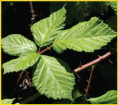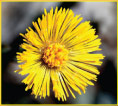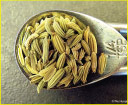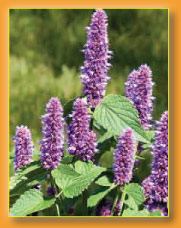|
|
 |
|
|
 Mark’s Herb Update Mark’s Herb Update
As you might imagine Summer is a busy time on the farm. After a very long cool spring summer has exploded on the scene and the plants are shooting up in the heat.
There is so much to do; long days, equipment to fix, irrigation pipe to move. The work is long and hard and by the time night rolls around I am beat. But the reward is great too. From the bright yellows of the Mullein, California poppy, and Calendula, to the electric magenta of the Echinacea, and the deep purple of the Hyssop the farm is alive with color.
As I walk through the fields on my rounds I see that the stand of rye is almost ready for harvest. When I pick and rub a head the kernels fall firm and ripe into my hands. Soon I will be on the combine to bring the harvest in.
One of our specialties here at Pacific Botanicals is discovering ways to cultivate herbs that grow in the wild. One of the new crops we are growing for the first time is Plantain. As many of you know Plantain contains a high percentage of mucilage, which gives it it’s soothing
properties; allantoin, to speed wound healing; and aucubin, a strong antimicrobial substance,
to help prevent infections. It is usually wild harvested in eastern Europe. It is exciting for us
because we are now one of the only people growing it commercially here in the U.S.A.
Another enjoyable and rewarding part of my job is the guided tours of the farm that we
offer for various herb organizations. I love to take students who are excited about herbalism to
see, touch, and taste our organic herbs out in the fields, and observe and understand the processes of organic farm production. Their enthusiasm
never fails to inspire me. I am excited about each opportunity I have to spread the good news about herbalism and support people who want to
enter into this healing profession.
Well, I guess that’s about it for now. Hope you and your family are in good health and that you are enjoying summer wherever you live. Until
next time. Mark
Mark Wheeler - Founder, Pacific Botanicals |
 |
|
|
|
 Toni’s Window on the Field Toni’s Window on the Field
Check Out These Fantastic New Products!
One of the many perks of my job is the connection I feel and the relationships I have developed with colleagues in the industry. My husband David and I took a working tour of some of our
customers and suppliers in Oregon and Washington. The beauty in Northern Oregon was breathtaking!
The volcanic mountains, the lush green rivers, the amazing trees, and the wonderful farm
lands were all so inspiring as we stopped and visited with our colleagues.
It is important for us to not only stay current with our colleagues to make sure that the quality
standards that we expect are shared, but also to spread the joy and committment of this good work.
I was struck by how many fine and caring people work in the herbal industry. David and I made
such a great connection with so many good people. I was struck by our common values for the earth, for conservation of resources, for recycling,
for organic pesticide free growing, and for the honoring and support of workers. These values are close to my heart. I felt part of a community.
One of the things that David mentioned was that working with the herbs means that we also are under their influence. I had not thought of
this before. But it makes sense. Here on the farm we work ever day surrounded by fields of Echinacea, Oats, Red clover, Ashwahghanda, California
Poppy, Hyssop, Elecampane, Rye, Valerian, Chamomile, and Linden, just to name a few. The living energy in these plants is having an effect on
us, healing, calming, inspiring, and connecting us to the living process of the earth. As we have an impact on the plants so do the plants have an
impact on us.
I am so glad we took this trip and hope to take others throughout the year. Building relationships with our fellow healing workers is a big part
of the work I love. I think it is an effect that the healing herbs have on us all.
I hope your summer is fun and full of rest and renewal. All the best from our community to yours. Toni.
Toni Evans, Cheif Operating Officer Pacific Botanicals |
|
|
|
|

 Blackberry Leaf Blackberry Leaf
The leaves are used for treating non-specific
acute diarrhea, as well as inflammation of the
mouth and throat. They also reported to be
helpful in reducing blood sugar levels and are a
good source of the vitamins C and E and the mineral, selenium.
Herbalists and naturopaths also use also use blackberry leaves and
roots to treat dysentery and hemorrhoids. The tannins in blackberry
leaves are astringent and help blood to clot, which gives credence to
their traditional use to help heal wounds, open sores and scratches. To order click here. |
 Bilberry Bilberry
Bilberries are antiseptic and astringent and have been used for diarrhea, diabetes, and inflamed
gums. There is also evidence to show
they can be used to improve vision (especially
night vision) and circulation disorders, due to their high content of
anthocyanosides, which are blue to purple pigments. Bilberry jam was
used by English pilots in World War II to improve regular and night
vision, and Europeans have long used the extract to reduce capillary
fragility. Research shows that Bilberries contain anti-ulcer and anticarcinogenic
activity as well. To order click here. |
 Coltsfoot Coltsfoot
Coltsfoot is a water-loving plant that grows
naturally in Europe, but is a garden favorite
worldwide. It has been used for centuries, both
in folk medicine and modern herbal practice, to
help alleviate the symptoms of cough and upper
respiratory tract congestion during a flu or cold, whooping cough,
laryngitis, bronchitis, or asthma. It has expectorant, demulcent, antiinflammatory
and antispasmodic properties. To order click here. |
 Sweet Fennel Seed Sweet Fennel Seed
Unlike most fennel this fennel seed has
a sweet taste. A tea made from sweet fennel
seeds is widely used for relieving gas, dyspepsia,
stomachache, and colic, for children and
adults alike. Sweet fennel seed tea is sometimes
taken to help rid the lungs of phlegm. Mothers drink it to increase
the flow of breast milk. Sweet fennel seed poultices may be used
for conjunctivitis. In Chinese medicine sweet fennel is said to relieve
indigestion and vomiting and to stimulate the appetite.
To order click here. |
 Hyssop: Healing from Ancient Greece to the Present Hyssop: Healing from Ancient Greece to the Present
Hyssop is believed to have originated in southern Europe and adjoining regions of Asia. It can be traced back
almost unchanged to the Greek hyssopos. This in turn is drawn from the Greek or Hebrew azob or ezob meaning “holy
herb,” because it was used for cleaning people and sacred places and came to be known as a symbol of cleansing and
purification.
Traditionally, hyssop is one of the historic strewing herbs which would correlate with the old beliefs of its ability
to disinfect. As mentioned earlier, hyssop is used as part of respiratory tonics, as an anti-flatulent and perspiration
inducing herb and as a de-stresser.
A concentrated tea or infusion prepared by steeping hyssop leaves and flowers makes for an excellent respiratory
tonic that is efficacious in chest and respiratory congestion and in the accumulation of mucus. The infusion also is
an excellent digestive tonic.
It is also used in external applications to reduce swelling and bruising. There is a traditional English remedy for
the quick healing of bruises and cuts which also apparently prevents the onset of tetanus. This involves an application of crushed hyssop leaves
and sugar. An essential oil extracted from hyssop leaves is said to increase mental alertness and acts as a nervous relaxant. It is useful as a remedy
for nervous complaints like anxiety and depression. To order click here.
|
|
| |
|
|
|
 A Short Story A Short Story
of The Amazing Oat
Our Good Friend Avena Sativa
That’s our farm manager Dave harvesting oat straw for drying. These oats are in
the milk stage and are at the height of there medicinal potency. But oats are not only
used to heal the body at Pacific Botanicals they are used as a cover crop to nourish and
replenish the earth.
They are a valuable cover crop because they suppress weeds. Oats germinate very
quickly and are able to smother out emerging weed species. In addition oats release allelopathic
compounds, plant-made chemicals that hinder weed growth for several weeks.
Another benefit of oats as a cover crop is in soil improvement. Avena sativa produces
about 2 tons of organic matter per acre of ground. Incorporating oats into our soil improves the soil health by
improving the soil structure and tilth (loamy, nutrient rich soil, which improves water filtration). As the plant
residues decompose, the additional organic matter also encourage the formation of a rich, beneficial microbial
soil food web.
The medical benefits of Oats are varied. In the milky stage oats are used to enhance well being and reduce
anxiety. Oats are an annual grass that is high in calcium. Calcium rich herbs are the basis for remedies that relax
the muscles and nervous system. Avena sativa should be thought of as the basis for every good nerve relaxing formula. Tinctures of Oat straw can be
used for nerve complaints and for uterine problems. Oat straw tea is recommended by herbalists to soothe chest complaints, especially when mixed
with a little lemon and honey. Oat straw also makes a good wash for skin diseases, for flaky skin, itching, frostbite, and chilblains. Click to order oat straw here.
|
|
|
|
|
 Herbal Industry News Herbal Industry News
AHPA Defends the Herbal Industry Against Consumer Reports Magazine
American Herbal Products Association slammed an ill informed and sensationalized article in the September 2010 issue of Consumer Reports
called, “Dangerous Supplements: What You Don’t Know About These 12 Ingredients Could Hurt You.” The Dirty Dozen, as the article labels them,
include aconite, bitter orange, chaparral, coltsfoot, comfrey, country mallow (sida), greater celandine, kava, lobelia, and yohimbe, and non herbal ingredients colloidal
silver and germanium.
Most of these herbs are little known to the mainstream as observed by Matt Laurer on the CBS Today Show while interviewing CR’s Senior
Program editor on August 3. Indeed according to Mark Bush at Nutrition Business who provided figures that estimate that these 12 ingredients>
comprise less than 0.2% of the annual supplement market.
Although the article compares the “Dirty Dozen” with 11 “Supplements to Consider” saying that these are good for you, its basis for condemning
the 12 is ill informed and inflammatory reporting. Michael McGuffin, president of AHPA, in an interview for WebMd said, “Consumer
Reports is attempting to draw broad conclusions about the regulation of dietary supplements based on anecdotes related to products that do not represent the mainstream…Much
of this article is focused on individuals who suffered significant adverse events when taking product labeled as dietary supplements. These include one unfortunate man who took a
product found to be laced with a synthetic steroid, and another who suffered from a product found to contain 200 times as much selenium as was stated on its label. But the first
of these products was an illegal drug, and not a dietary supplement, and the second failed to comply with good manufacturing practice, and so was adulterated. This tone (of this
article) is unfortunate and misses an opportunity to express support for the efforts of responsible industry players to improve enforcement of the good laws already in place.”
At Pacific Botanicals we feel that the CR article again exhibits (they did this same sort of thing in 2004) a dangerous lack of expertise and
attempts to paint the herbal industry in an irresponsible light in a sensationalized scare tactic to sell magazines. As in any industry there are the
good guys and the bad guys. Mostly responsible knowledgeable players and and a few fast and loose players. The responsible players will follow
good manufacturing practices and provide warnings on products that require them. Here is an example of the responsible perspective.
Coltsfoot: AHPA has recommended since 1996 against the oral use of any herb that contains toxic pyrrolizidine alkaloids-including Coltsfoot
and also comfrey, which was retained by CR from its 2004 list. The Food and Drug Administration declared in 2001 that it considers any
product for oral use that contains toxic pyrrolizidine alkaloids to be adulterated, and the Federal Trade commission has also acted against the
sale of such products.
Country Mallow Sida cordifolia: CR has identified concern about “country mallow” based on “possible dangers linked with its ephedrine
alkaloids.” If there is any ephedrine in Sida cordifolia, however (recent research suggests there is not), it is present only at a very low level, less
than 0.1 percent. And if this herb was, in fact, providing ephedrine it would not be legal to use in a dietary supplement.
Several of the herbs identified in the article are labeled to inform consumers of safety issues material to their use. For example, AHPA
maintains a labeling policy for Kava (Piper methysticum) that provides information that is consistent with FDA’s 2002 Consumer Advisory on
this herb. And Chaparral (Larrea tridentata), Lobelia (Lobelia inflata), and Yohimbe (Pausinystalia johimbe) are all classified by AHPA’s Botanical
Safety Handbook. These facts support responsible use and while still acknowledging the healing potential of many of these herbs when used
under professional supervision. |
|
| |
|
 Behind the Scenes by D.E. Behind the Scenes by D.E.
I am walking and the summer heat is close rising in waves. There is the noise on
the surface of things where the woodpecker taps for bugs. Where the workers hoe the
ground. Where the tractor hauls the poppies to the dryer. Where the quick river flows
under the bridge. Where the truck passes by in a hurry tossing up a brown cloud of
dust in a frenzied swirl. Where the engine brake from an eighteen-wheeler thunders
down on the Fish Hatchery Road.
But what is happening behind the insistent clatter, the turning wheels, the automatitic
two-for-a-dollar-all-you-can-eat world of the ten thousand things…? What is
happening when I listen and look to the world behind the scenes. There in the purple
spires of the lavender and the splendid pink and amber of the Echinacea cones?
I will tell you. The flower petals rise and fall in the heat like tiny wings. The humming of the bees is like a love drone from the eternal. They
crawl over the glowing golden cones gathering the nectar and drawing me in. I can’t resist. I get closer. I don’t want to be stung. But I want to be
close. So I risk my naked arms. There are hundreds and hundreds of bees. They move efficiently in the heat. They
are not in a frenzy but still  they dance the life pattern with abandon. They buzz around my legs. Time slows down...
just the buzzing...the pink hazy glow...and the graceful waving of the rich green stalks. They take me to the center.
Behind the scenes. Where the sweet nectar flows and the green world is being made. they dance the life pattern with abandon. They buzz around my legs. Time slows down...
just the buzzing...the pink hazy glow...and the graceful waving of the rich green stalks. They take me to the center.
Behind the scenes. Where the sweet nectar flows and the green world is being made.
I turn for a moment and look at the white box hives up the dirt road. I wonder how the fresh honey will taste.DE |
| |
|
|
|

